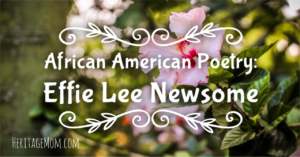

The children's issue did not address at the child's level a socio-political concern that was then on Du Bois' mind. This direct focus on the needs of children was important because the annual "Children's Number" in Crisis (a focus issue that commenced in 1912) was primarily devoted to materials that could inspire and admonish adults in their child-rearing role.


Her column would be a continuation of The Brownies' Book tradition. These goals did not change substantially when Effie Lee Newsome, in 1925, began developing them in "The Little Page" within Crisis.
#EFFIE LEE NEWSOME CODE#
Other aims were as follows: to teach Negro history and biography to teach "a code of honor and action" in the black child's relations with white children to turn "hurts and resentments" into ambition and love of the child's own home and companions to point out the best amusements and the worthwhile things of life and finally, to inspire children "to prepare for definite occupations and duties with a broad spirit of sacrifice" ("Opinion", 1919, 286). The first item on the agenda was to show that "colored" was a normal, beautiful thing.

To Children, who with eager look Scanned vainly library shelf and nook, For History or Song or Story That told of Colored Peoples' glory,- We dedicate The Brownies' Book.ĭu Bois set forth the goals of the new magazine, which began publication in 1920 and ended two years later. People who are today well-known in the field of black literature-e.g.,Jessie Fauset, James Weldon Johnson, Langston Hughes, Georgia Douglas Johnson, and Du Bois himself-contribute to the pages of The Brownies' Book. I will preface this review of Newsome's writings, then, with a brief account of The Brownies' Book enterprise, and with a description of the public conditions that induced it. Their work together is an important part of Newsome's story, for it was Newsome's job to carry on within the pages of Crisis Magazine (the NAACP monthly) what Du Bois had tried to achieve in his periodical for children, The Brownies' Book (also under NAACP auspices). Newsome's contribution to children was aligned to some degree with that of W.E.B Du Bois, her editor in the early days of the NAACP. The basic outline of the black aesthetic was not significantly influenced by whether works were addressed to children or adults. But she also embraced the broader aims of the black artist, for the times as well as purely personal interests called for a response. She was primarily a nature poet, giving voice to her love of the out-of-doors. Effie Lee Newsome was a writer who fulfilled these goals in the children's literature of the 1920s. This mission includes refuting the misconceptions about blacks that produce exploitation and bigotry it means giving expression to the realities of black experience and it means utilizing skillfully the aesthetic conventions pertinent to the immediate creative task. African American artists have had a relatively unaltered artistic mission over the years, a continuity of focus induced by unyielding and problematic features in the political landscape.


 0 kommentar(er)
0 kommentar(er)
